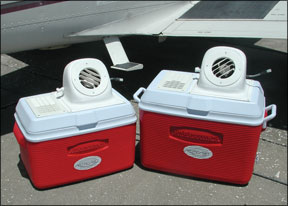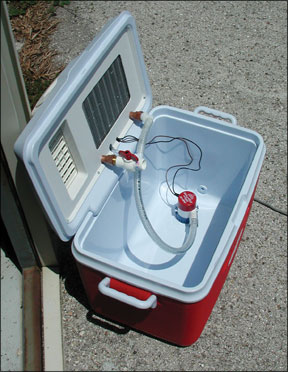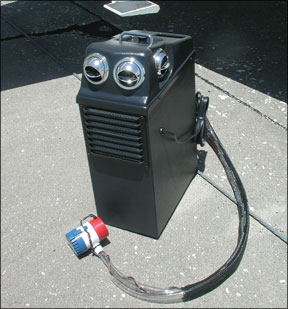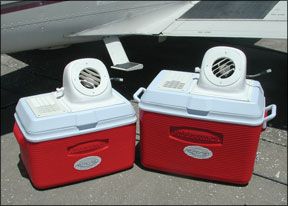There are three reasons why more airplanes don’t have air conditioning: Its expensive, its heavy and saps payload and no matter how hot it is, you usually don’t need it above 5000 feet. So most owners just go without and swelter through the hot months. As an alternative to sweat and bear it, a cottage industry has sprung up offering portable coolers for the cockpit which circulate air through block or crushed ice stored in a modified picnic cooler. Weve seen these products at trade shows and on the Web and our reaction is always some version of this: They cant possibly work, can they? Actually, they do work and although not practical for all owners, they offer a limited alternative to the cockpit steam bath. But any buyer considering one shouldnt expect a cockpit chilly enough for a sweater in July. Theyll cool the cabin or, more accurately, theyll spot cool the occupants enough to improve hot weather comfort, but its unrealistic to think of them as air conditioners-they simply don’t have the cooling capacity.
Simple Theory
Blowing air through a pile of ice will make it cooler and that, in effect, is the operating theory of these devices. But theyre more sophisticated than that, even though they may look like ordinary picnic coolers with a fan on top. Arctic Air sells eight models of air coolers-two ice chest sizes, 12- or 24-volt fans and two models with directable ducts. Prices range from $475 to $625. (See http://www.arcticaircooler.com/.)

We know what youre thinking: Hey, I could make one of these in my garage for less than that. Were not so sure, frankly.
Consider that the Arctic Air models operate both on a chilled water and chilled air cycle. For chilled air, the fan draws air across the surface of ice stored in the cooler-it works, but not well. The chilled water cycle uses a submersible electric pump to circulate water from the cooler through a heat exchanger coil through which the fan draws air.
The system is equipped with a cutoff valve that allows the meltwater to be pumped out through an extension hose. The Arctic Air units are not, by strict definition, swamp or evaporative coolers which work by providing light water misting to create a cooling effect. Evaporative coolers work we’ll in dry air, but tend to add to the misery in humid weather.
One company that does make true swamp coolers is the appropriately named Swampy Cooling Systems, which sells coolers for golf carts, boats, RVs and so forth, including aircraft. (see http://www.swampy.net/) Swampy sells coolers that operate both on the evaporative cooling principle and on ice cooling, selectable by the user. The model Swampy sent us for testing-the $587 IM30-uses a chilled water cycle identical to the Arctic Air products. Swampy coolers suitable for airplanes ranging in price from $297 to $627 and are available in 12-, 24- and 110-volt models.
A third company, Pol-Air, is developing yet another aircraft spot cooler which uses an air/ice circulation concept and directs spot cooling through hoses to each cabin seat. In the July 2002 issue, we reviewed this companys earlier product, then called Porta-Chill. That product has been discontinued, although it still appears on the companys Web site at http://www.pol-air.com/. Company principle Ralf Blackstone

showed us a prototype for his new product, which is expected to be available later this summer. However, the version we examined wasnt ready for testing. we’ll have another look later in the year.
Ground Trials
We tested two of the Arctic Air Models, the smallest-PAC24-1-12 at $475 and the larger PAC34-1-12, which sells for $495. These two products are identical in construction, except that the PAC24 has a Rubbermaid ice chest measuring 16 by 12 by 20 inches while the PAC34 ice chest measures 21 by 13.5 by 20 inches. The principle distinction between the two models is that the larger one holds more ice and cools longer, but it doesnt cool any more effectively for as long as the ice lasts.
To try the coolers, we heat soaked our Mooney on a hot ramp with ambient temperatures at 90 degrees F. Cabin temperature inside the airplane was we’ll over 100 degrees F. Arctic Air instructs the user to fill the bottom portion of the cooler with water, then top it off with ice. We aired out the airplane to give the cooler a fighting chance, placed the cooler on the backseat and installed datalogging thermometers inside the cabin. The makers of these portable coolers don’t sell them as room air conditioners, but spot air coolers meant to improve comfort of occupants in a small space-a fair and accurate claim.
Limited cooling capacity is the reason. A typical automotive air conditioning system can summon 12,000 to 16,000 BTUs of cooling, but a portable ice-based system provides only a fraction of that. A pound of ice is worth 143 BTUs of heat absorption at 100 percent efficiency, so the best 40 pounds of ice can do is about 5700 BTU. The reality is less than that due to imperfect heat transfer.
Running the Arctic Air coolers on the low setting didnt provide much cooling. In fact, it was barely measurable. We surmise that this is due to inefficient heat transfer, since the low setting merely draws warm inlet air across the surface of the ice inside the cooler. On the low setting, the inlet/outlet temperature drop was about 15 degrees after 10 minutes, yielding a high volume of 70-degree air that provides some relief, but not much.
With the cooler running on the high setting, which pumps chilled water through the heat exchanger coil, we measured an inlet/outlet temperature drop as much as 27 degrees. At its best, the cooler was blowing 59-degree air. This is quite noticeable in the front seats and it reduced the cabin temperature from about 93 degrees to 81 degrees. Not quite as cool as a we’ll air-conditioned home or office, but more comfortable than a broiling cabin with no cooling.
A compressed-gas air conditioner improves comfort by reducing humidity, but the ice-based coolers do the reverse. As the cooler continued to run, the cabin humidity crept up from the 28 percent ambient to around 37 percent. In one test, it rose to 57 percent. It didnt feel humid in the cockpit, but the comfort level would be higher if the humidity were below 50 percent.
The Achilles heel of ice coolers is, of course, the ice. The hotter the cabin, the longer you want it to last. But the hotter it is, the quicker it melts. Running on high, the Arctic Air coolers are remarkably efficient at turning ice into warm water. With the cooler jammed full of ice and minimal water for circulation, the smaller unit cooled we’ll for one hour and 20 minutes, while the larger cooler lasted two hours before the ice melted. Loaded weight for the small cooler is 39 pounds and 60 pounds for the larger models.
Swampy
We tried Swampys IM30 under similar conditions and although the Swampy works on chilled water, the IM30 doesnt have its own cooler-you supply your own and then stick a submersible pump with a return line into it. Size the cooler according to how long you want cool air. (Other models have ice chests included.)
The Swampy has a high volume three-speed squirrel cage blower with directable eyeball vents. It weighs 15 pounds, plus 25 to 40 pounds for the ice chest, depending on size. We deem the construction to be a cut above the Arctic Air, with a purpose-made plastic cabinet, nicely crafted vents and an automotive-style switchable fan.
However, we were disappointed with the performance. According to our instruments, the Swampy blew air at only 70 degrees-not bad, but the Arctic Air chilled to 59 degrees. We think one reason for this is that the Arctic Air pump is rated at 500 GPH while the Swampy has a 360 GPH pump. Ice consumption confirmed this. The Arctic Air burned through 20 pounds of ice in 30 minutes, but the same amount lasted the Swampy nearly an hour. The Swampy can direct air toward the cabin occupants, which helps, but overall, it cooled the cabin only about 5 degrees.
The Swampys instructions warn to keep the cooler above the level of the ice chest to avoid siphoning cold water back into the unit itself. Sure enough, this happened to us and we had to dump the water out at the end of the test. None spilled in the aircraft, but the Swampy lacks the Arctic Airs pump out feature, so you have to wrestle 30 or 40 pounds of meltwater out of the airplane, which is awkward.
Conclusion
If youre thinking of buying one of these things, consider the unavoidable nuisance factor. you’ll have to buy or bring ice, load the cooler and schlep it into the backseat or baggage compartment, then deal with the meltwater at the end of the flight. you’ll have to give up 40 to 60 pounds of payload and perhaps a passenger seat or two.
In exchange, you’ll get not a cool cabin, but enough local cooling to knock at least some of the sweltering misery off hot weather ground operations. Of the two products, we like the Arctic Air products best, because theyre entirely self-contained, can double as drink and food coolers and the pump-out feature makes them easy to handle. Further, they performed better than the Swampy did and we found Arctic Air cooperative and easy to deal with.


